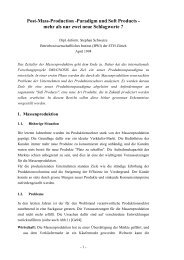The China Venture
The China Venture
The China Venture
Create successful ePaper yourself
Turn your PDF publications into a flip-book with our unique Google optimized e-Paper software.
established in January 1996 by 59 private companies. Minsheng is carving out a niche in<br />
<strong>China</strong>’s growing private sector, a customer base long neglected by the larger state owned<br />
banks. It may be <strong>China</strong>’s smallest national commercial bank, a minnow compared to the state-<br />
owned giants of <strong>China</strong>’s banking industry, but its aspirations are big. 34<br />
<strong>The</strong> most important domestic competitors are the four state-owned specialised banks, which<br />
together have about 120’000 branches in <strong>China</strong>. <strong>The</strong> ICBC, for example, is the biggest of<br />
<strong>China</strong>’s big four state banks in terms of assets and employees. ICBC still allocates 70% of its<br />
loans to state firms. 35 <strong>The</strong> Bocom and the specialised banks are highly affected by the<br />
government policy granting loans to SOEs among the state -owned banks. <strong>China</strong>’s state banks<br />
are being undermined by the sheer scale of non-performing loans, although the conversion of<br />
central bank loans into equity would improve capital adequacy ratios and could be the first<br />
substantive step towards restructuring the sector. <strong>The</strong> increasing number of new banks pushed<br />
the existing specialised banks to further reforms in transforming themselves into market-<br />
oriented commercial banks, which try to be more flexible and customer focussed. Service at<br />
Chinese banks is getting better, but is still very poor. Nevertheless, since all business in <strong>China</strong><br />
requires to be conducted in RMB, it’s wise to let financial transaction done by domestic<br />
banks. <strong>The</strong> Shanghai government has directed local banks to favour loans to priority<br />
infrastructure projects, and all fixed-asset loans by <strong>China</strong>’s banks have been under the control<br />
of the central government since January 1994. This makes them not very reliable as a source<br />
for operating credits for either foreign or Chinese firms.<br />
Priority in the reforms, will be given to recapitalising the big four state-owned banks, while<br />
some smaller banks will be allowed to fail. This became clear as the Hainan Development<br />
Bank went bankrupt. Losses from its closure were covered by the authorities, but this may not<br />
be the case once closures and bankruptcies gain pace.<br />
Foreign Banks<br />
<strong>The</strong> restrictive regulatory environment, most notably the ban on RMB business, has<br />
discouraged and prohibited foreign banks from playing a prominent role in <strong>China</strong>. Foreign<br />
banks have historically not been allowed to open RMB accounts for customers, but they have<br />
been permitted to open foreign currency accounts for FIEs in Special Economic Zones. 36<br />
Nevertheless, by the end of 1995, 120 branches and 469 representative offices of foreign<br />
34 Business <strong>China</strong>, 1998, p. 12.<br />
35 Business <strong>China</strong>, 1998, pp. 12.<br />
27






